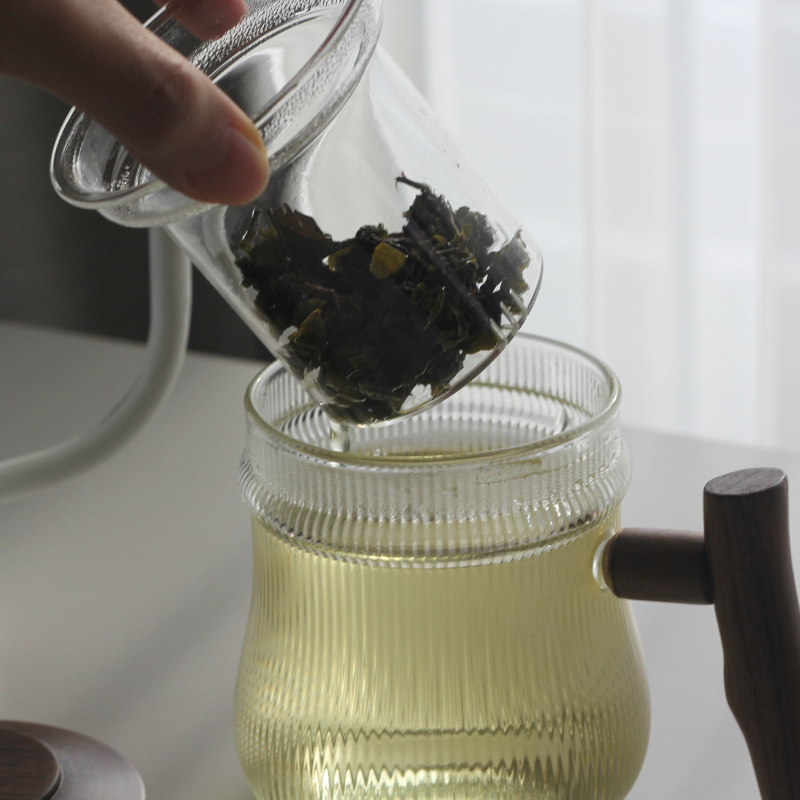TEA JOURNEY | Newly invented hojicha that's made with oolong tea?
That's right.
Our Hojicha isn't just Hojicha, but Baozhong Hojicha—quite a unique name, isn't it?
Baozhong Hojicha is a tea developed by reinterpreting Japan's Hojicha using "Wenshan Baozhong (pouchong)," a famous Taiwanese oolong tea known for its low oxidation and floral aroma, as its base.
Developed, you say???
That's right.
"Baozhong Hojicha" is Tinge of Soul’s signature tea, created with creativity and our Taiwanese tea master. From sourcing raw ingredients, determining flavor profiles, the grind size, and to roasting levels, we went through all the steps needed to source and create something good.
So, here's the journey behind the creation of "Baozhong Hojicha."
Beginning with Coffee
Our development journey began with a simple question: Why has the demand for Hojicha recently increased?
The growing popularity of Hojicha, even in its country of origin, Japan, became clear through customer interactions, online reviews, and market insights. The main reasons customers choose Hojicha include:
- Seeking an alternative to reduce coffee consumption.
- Disappointment with the monotonous taste of roasted grain teas, despite their roasted notes.
- Preferring Hojicha for its lower caffeine content and richer flavor compared to other substitutes.
Thus, Hojicha is increasingly viewed as a low-caffeine alternative to coffee.
Customers can be defined as "those primarily seeking coffee alternatives for health or other reasons."
Next, we reflected on coffee itself: Why do people drink coffee, and who consumes it most frequently?
The answer quickly became clear: office workers. Overwhelmed office workers at their desks, in meetings, or post-lunch breaks invariably have coffee in hand. Coffee is deeply embedded in our lifestyle, meaning any substitute must seamlessly blend into that lifestyle without friction.
Identifying Frictions & Pain Points
What are the pain points that prevent tea from integrating seamlessly?
- New tools required: High-quality tea typically demands specialized teaware, causing friction for consumers.
- Ordinary flavor: Coffee provides robust, complex tastes, from fruity and nutty to sweet cocoa notes. In contrast, tea often feels plain and mild.
- Convenience: Coffee comes conveniently packaged in drip bags, tea bags, and capsules. Tea bags available in Korea struggle to accommodate whole-leaf tea properly, limiting convenience.
We set out to eliminate each of these frictions.
Searching for a Toasty, Delicate Flavor
Most coffee alternatives are grain teas, which, although roasted, lack coffee's complex taste. To achieve a roasted yet delicate taste with reduced caffeine, we chose "Wenshan Baozhong," a traditional Taiwanese oolong tea grown primarily in the Wenshan region. Known for its low oxidation (8%-18%), Wenshan Baozhong boasts a gentle floral aroma and refreshing clarity.
Higher oxidation teas exhibit immediate roasted notes, but we theorized the lower oxidation Wenshan Baozhong could first present familiar roasted notes. Our initial test involved "90% Baozhong stems and 10% leaves."
Unlike roasted oolong, this initial experiment presented no noticeable off-flavors. Though initially lacking in roasted depth due to shorter roasting time, adjusting roasting duration resolved this easily. However, emphasizing roasted flavors diminished Baozhong's characteristic floral finish.
Through numerous experiments adjusting leaf-to-stem ratios, roasting temperatures, and durations, we finally achieved our desired flavor profile.
Thus, Baozhong Hojicha emerged, offering "familiar roasted notes initially, followed by distinctive oolong depth, finishing elegantly with Baozhong’s floral fragrance."
By highlighting oolong’s inherent complexity, we reduced flavor friction compared to coffee.
Using Existing Tools
Given coffee's popularity in Korea, coffee brewing equipment is widespread, including hand-drip and French presses. We aimed for our tea to be compatible with existing coffee tools, removing the barrier of needing new teaware.
Therefore, we adjusted our ground size.
You can effortlessly brew Baozhong Hojicha by placing about 5 grams into a hand-drip filter, just like coffee. Moreover, the tea retains flavor consistency over multiple infusions.
If you own traditional teaware, it’s still perfect. However, as avid tea drinkers ourselves, we prefer larger quantities, conveniently brewed using a French press.
Convenience Everywhere
Standard tea bags in Korea cannot accommodate whole-leaf tea comfortably. Carrying personal teaware for drinking tea at work or school is inconvenient.
Thus, we introduced drip bags, enabling convenient enjoyment of whole-leaf tea anywhere. Simply steep the drip bag in water for about two minutes, and you’ll experience the tea’s full-bodied flavor and aroma.
Conclusion
Creating Baozhong Hojicha took considerable time because we aimed to deliver premium tea conveniently and affordably. Consequently, we managed the entire process—from sourcing raw materials to roasting and importing—in direct collaboration.
We hope everyone easily enjoys our Baozhong Hojicha everywhere. Its unique complexity promises to deliver moments of calm amidst busy lives.
We wish you a delightful day accompanied by Baozhong Hojicha!






![TEA JOURNEY [13] | Tea Tasting Terminology](http://tingeofsoul.com/cdn/shop/articles/IMG_3072.jpg?v=1686898175&width=1080)
Leave a comment